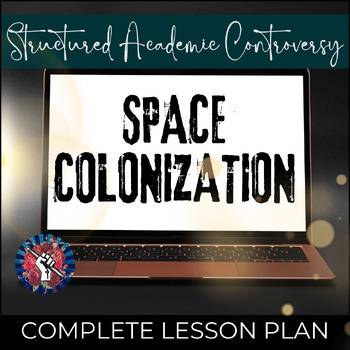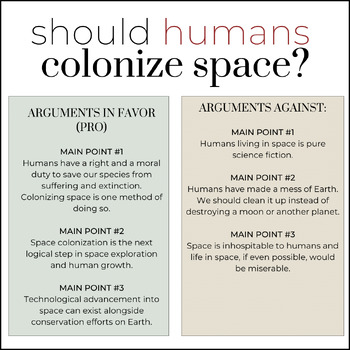Structured Academic Controversy Lesson Plan: Space Colonization
- PDF
Also included in
- The structured academic controversy lesson plan is one of the best discussion strategies in the classroom and critical thinking group activities because it relies on teamwork and respectful communication among students while developing close reading, writing, speaking, and active listening skills. BPrice $22.05Original Price $31.50Save $9.45
Description
This Structured Academic Controversy lesson plan provides you with one of the best exercises for critical thinking you can do with students that engages one of the most current debate topics for high schoolers today: Should Humans Colonize Space? The structured academic controversy lesson plan approach is one of the best critical thinking group activities because it relies on teamwork and respectful communication among students while developing close reading, writing, speaking, and active listening skills.
The controversy surrounding space colonization is important because it raises ethical and practical questions about the future of humanity. If successful, space colonization could provide a solution to the growing population and resource depletion problems on Earth, as well as ensure the survival of our species in the face of natural disasters or catastrophic events on Earth. However, it also presents a number of ethical and environmental challenges that must be considered, for example, some argue that the resources required to colonize other planets could be better used to address issues such as poverty, inequality, and climate change on Earth. Second, space colonization has significant economic implications. The cost of space exploration and colonization is significant, and it is important to consider whether the potential benefits outweigh the costs. Additionally, the economic benefits of space colonization could be significant, including the potential for new markets and industries. Finally, the controversy surrounding space colonization reflects broader debates about the role of technology and its impact on society. As technology continues to advance, it is important to consider the ethical and societal implications of new technologies, including those related to space exploration and colonization.
Benefits of using SACs include:
- Promotes critical thinking: SACs are one of the best exercises for critical thinking because they require students to deep-read and evaluate evidence from different perspectives.
- Fosters collaboration: SACs are designed specifically around promoting collaboration and teamwork, prioritizing active listening, and finding common ground
- Encourages respectful communication: SACs emphasize the importance of respectful communication and help students develop the ability to listen to and consider alternative viewpoints.
- Increases engagement: SACs are one of the best student engagement strategies because they are highly interactive and engaging, making it easier for students to stay focused and interested in the topic at hand.
- Builds confidence: SACs are known for building student confidence in the classroom because they provide opportunities for students to practice public speaking and advocacy skills, helping to build confidence and self-esteem.
What I love about the SAC format as an approach to debate topics for high schoolers is that, in contrast to many student topics for debate, it isn’t about what answer students get to, or who “wins”... it is 100% about the process. It provides us the opportunity to teach, model, and reinforce what it means to “listen to understand”, and gently guides teenagers to holding space for grey areas, for becoming comfortable with non-closure, and developing the habit of thought that will have them intuitively seek to understand points of view different than their own without being threatened by them.
More Structured Academic Controversies:
- Does cancel culture support democracy?
- Should historic statues be taken down?
- Should prisons be privatized?
- Student Loan Debt Elimination
- Defund the Police
- Universal Basic Income
Related Resources
- Systemic Oppression growing resource bundle
- Current Events Research Project: Student-led Presentations and Discussions
- Terrorism in the Modern World: Growing Bundle
- LGBT Civil Rights Timeline: A History Lesson
- Task Cards for AP World History: SPICE Themes
- Modern Social Movements: Anti-Corruption Protests in Russia Source Analysis
Product Details
- Google Slides presentation with step-by-step instructions to project for students for each portion of the structured academic controversy process
- Guided teacher notes, with instructions and notes for each slide
- Complete Team A and Team B packets for each group of four that includes
- Question for deliberation
- Background reading (same for both teams)
- Three main “for” and “against” arguments set up as guided reading with a corresponding space for students to summarize the main idea (answer key include for you)- Adapted from ProCon
- Guided small-group presentations with note-taking section
- Regroup and reverse roles; students identify the strongest points of opposing sides arguments
- Finding common ground activity
- Whole group debrief discussion with guiding questions
- Exit ticket: students process their own opinions and thoughts to the deliberation question at the end of the exercise
Let's Connect!
Learn more at teachingdissent.com
DID YOU KNOW?
You can get TPT credit to use on future purchases!
Here's how:
• Go to your My Purchases page.
Beside each purchase, you'll see a Provide Feedback button. Simply click it, and you will be taken to a page where you can give a quick rating and leave a short comment for the product. I sincerely value your feedback!
Follow me to be the first to know about my new discounts, free resources, and NEW products!
Look for the star near the top of any page within my store, and click it to become a follower. You will be the first to know about any new products from me!






